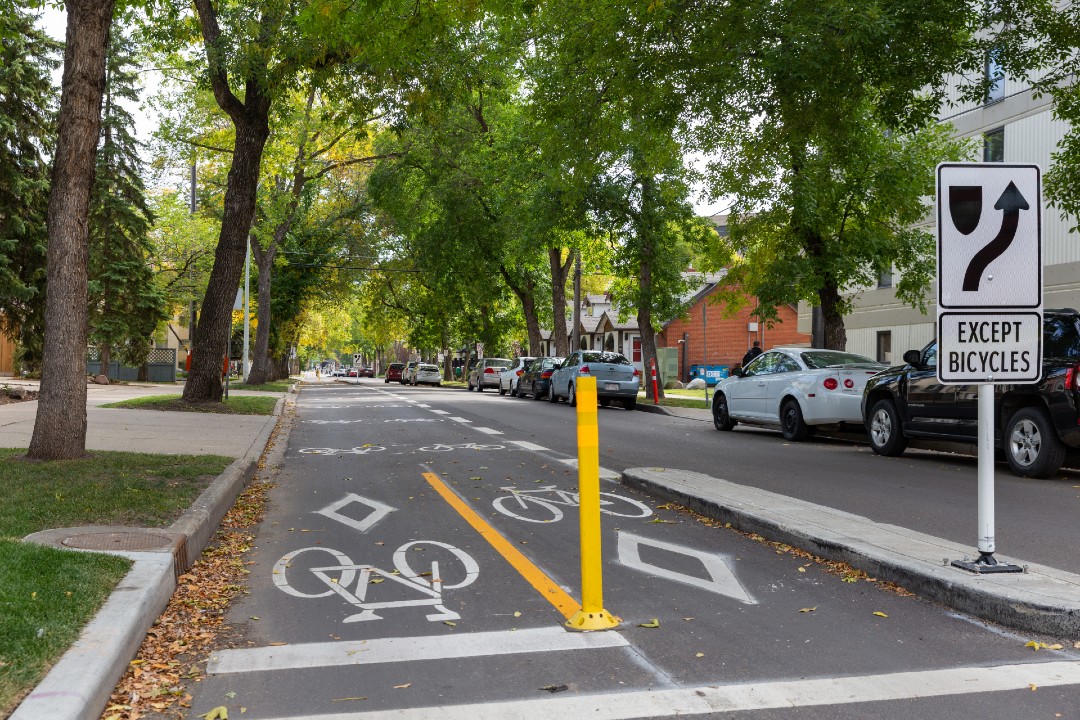About 10 years ago, while Michael Phair and other residents in Wîhkwêntôwin were pushing the city to build a bike lane in their neighbourhood, Anna Ho and Conrad Nobert were doing the same across the river in Strathcona. Eventually, the two sides teamed up to form Paths for People, which in the decade since has successfully advocated for Edmonton to build better options for people who walk, roll, and cycle.
Phair told Taproot that in Wîhkwêntôwin, formerly Oliver, about a dozen residents met regularly with the city and, generally, pushed for a bike lane that had three features: It should run along 102 Avenue, as there were more destinations there than on 103 Avenue (an alternative route some had suggested); it should cross busy 109 Street into downtown; and it should look nice. The group staged a temporary lane using flower pots along 102 Avenue and invited people to ride their bikes in it. The goal was to show the city that there was a demand for a protected bike route. The city listened. It built a two-kilometre protected bike lane in Wîhkwêntôwin that opened in late 2017.
"Well, it's worked extremely well. I actually happen to live on 102 Avenue, and the number of people on bicycles, scooters, all kinds of vehicles, roller skating, skateboarding, is huge," Phair said. Today, tens of thousands of cyclists use the path each summer, and a few thousand each month in the winter, according to a bike counter set up at 102 Avenue and 121 Street.
This summer marks 10 years since Phair, Ho, and Nobert teamed up to create a registered non-profit with a board of directors, and expand their focus to include all forms of active transportation, including walking, rolling, scooting, and biking. To celebrate its 10th birthday, Paths for People has a handful of events lined up.
The group is hosting an Open Streets event on June 7 adjacent to the Quarters LRT stop. And though Phair, Ho, and Nobert are no longer with Paths for People, Cheryl Villetard, current co-chair of the group, told Taproot there will be market vendors, food trucks, and family-friendly games. Just nearby, Ociciwan Contemporary Art Centre will host an art market and Van Loc will hold its second annual VanBloc Party. Paths for People will reveal the results of its crowd-sourced Missing Links survey at the event.
The group will also kick off an eight-week fundraising campaign. The Government of Alberta will match 50% of every dollar donated through the Alberta Crowdfunding website. On July 17, Paths for People will host Ray Delahanty, content creator behind the YouTube channel CityNerd, for a panel about urbanism, housing, and transportation.
Paths for People has received the most attention for its lobbying for the downtown bike grid, installed in 2016 and 2017; the $100-million accelerated bike plan, approved in 2022 and currently under construction; and the Old Strathcona Public Realm Strategy, which was finalized in 2024 and is partly underway.
But Villetard said it's not just these bigger achievements she's proud of. The group has also hosted community-based activations like car-free nights on Candy Cane Lane and open streets events, and has worked to educate people about how to cycle safely in Edmonton with webinars and mentorship programs. Paths for People even contributed to the pedestrian-only entertainment district on Rice Howard Way downtown.
The group is also asking Edmontonians about missing sidewalk links in their neighbourhoods and where the pedestrian experience can be improved downtown.

This bike lane in Wîhkwêntôwin was a seed from which Paths for People sprouted. The organization celebrates its 10th year this summer. (Mack Male/Flickr)
Phair said the city's attitude about active transportation has changed in the past decade.
"It's wonderful to see it happen," he said. "I think for a city of our size to not have bike routes would be crazy. That's part of urban living these days ... I think it has been kind of adopted and built into the city and how it sees roads."
Of course, not every Paths for People proposal has been successful. Earlier this year, it pushed to remove vehicle traffic from one part of 76 Avenue in the Ritchie neighbourhood when the city renewed a culvert in the ravine, much to the consternation of several community leagues, who represent residents that depend on the road. The city recently released its final design for project, showing that it intends to keep vehicle traffic capacity as it is.
Villetard said during the 2021 municipal election, the organization "did a lot of work garnering a good group of (city) council that can bring the political will needed to make change."
As the next municipal election approaches in October, the provincial government has considered interfering to remove existing bike lanes or cancel planned bike lanes.
Despite this, Villetard remains hopeful for the future of active transportation.
"I'm optimistic that everyone, or the majority of people, will show support behind these initiatives, because they really do benefit everyone, even car drivers," she said.
Phair, who was a city councillor from 1997 until 2007, said it will be important for the new council to make active transportation a priority every year.
"I think one of the hard lessons I learned in city hall, when the LRT was built and then nothing happened for 30 years, is that if you don't put something in the budget every year, it just doesn't happen," he said. "Because then you've got to bring something back in. When you put money into the budget under bike routes, and you have some money every year, things get done. If you ever stop that, it's hard to bring it back."
Clarification: This story has been updated to clarify that the proposed closure on 76 Avenue was for a part of the avenue, not the entire avenue.
